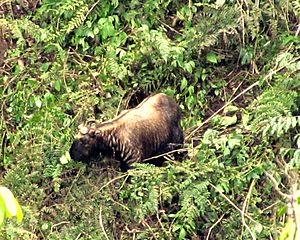Bhutan takin facts for kids
Quick facts for kids Bhutan takin |
|
|---|---|
 |
|
| Bhutan Takin, Jigme Dorji National Park | |
| Conservation status | |
| Scientific classification |
|
| Kingdom: | Animalia |
| Phylum: | Chordata |
| Class: | Mammalia |
| Order: | Artiodactyla |
| Family: | Bovidae |
| Subfamily: | Caprinae |
| Genus: | Budorcas |
| Species: | |
| Subspecies: |
B. t. whitei
|
| Trinomial name | |
| Budorcas taxicolor whitei Lydekker, 1907
|
|
The Bhutan takin (Budorcas taxicolor whitei) is a unique type of animal that lives in the high mountains. It is a subspecies of the Takin, which is a large mammal that looks a bit like a goat and an antelope. This special takin lives in Bhutan, northeastern India, parts of western China, and Tibet. Sadly, the Bhutan takin is considered a vulnerable animal. This means its numbers are decreasing. The main reasons for this are hunting and the loss of its natural home, called habitat loss.
Contents
What is the Bhutan Takin?
The Bhutan takin is a very interesting animal. It belongs to the Bovidae family, which includes cattle, goats, and sheep. Takins are known for their strong, muscular bodies. They have a thick, shaggy coat that helps them stay warm in cold mountain areas. Their fur can be golden, brown, or even black.
Physical Features of Takins
Takins are quite large animals. An adult takin can weigh between 550 and 770 pounds (250 to 350 kg). They can stand about 3 to 4 feet (90 to 120 cm) tall at the shoulder. Both male and female takins have short, sturdy horns. These horns curve backward and then upward. They are very useful for defending themselves.
What Do Takins Eat?
Bhutan takins are herbivores, which means they only eat plants. They spend their days browsing on different types of plants. Their diet includes leaves, bamboo shoots, bark, and various herbs. They often move to different altitudes to find the best food. This helps them get all the nutrients they need.
Where Do Bhutan Takins Live?
The Bhutan takin lives in the eastern Himalaya mountains. These mountains are very rugged and challenging. They prefer to live in dense forests and bamboo thickets. These areas are usually found at high altitudes. They can be found from about 3,300 feet (1,000 meters) up to 14,000 feet (4,300 meters) above sea level.
Their Mountain Home
The mountainous terrain provides them with good cover. It also protects them from predators. They are excellent climbers, even though they are large. Their strong legs and hooves help them move easily on steep, rocky slopes. They often travel in herds, especially during the summer months.
Why Are Bhutan Takins in Danger?
The Bhutan takin is listed as "vulnerable" by the International Union for Conservation of Nature (IUCN). This means they face a high risk of becoming extinct in the wild. There are two main threats to their survival.
Threat 1: Hunting
One major threat is hunting. People sometimes hunt takins for their meat and their horns. This illegal hunting reduces their numbers. It makes it harder for the population to grow.
Threat 2: Habitat Loss
The other big threat is habitat loss. This happens when their natural home is destroyed or changed. Human activities like building roads, expanding farms, and logging can take away their forests. When their habitat shrinks, takins have less space to live and find food. This also makes them more exposed to human contact.
Protecting the Bhutan Takin
Many efforts are being made to protect the Bhutan takin. Governments and conservation groups are working together. They want to make sure these unique animals survive for future generations.
Conservation Efforts
One important step is creating protected areas. For example, the Jigme Dorji National Park in Bhutan is a safe haven for takins. These parks help protect their habitat from human activities. Laws are also put in place to stop illegal hunting. Raising awareness about the takin's importance is also key. This helps people understand why these animals need our protection.
Fun Facts About Takins
- The takin is the National animal of Bhutan. This shows how important it is to the country.
- Takins are sometimes called "cattle chamois" or "goat antelopes." This is because they have features of both animals.
- They have a special oily substance on their fur. This helps to repel water and keep them dry in wet mountain weather.
- Takins often gather in large herds during the summer. In winter, they break into smaller groups to find food more easily.
- They can make a variety of sounds, including a loud cough or a roar, especially when they feel threatened.


